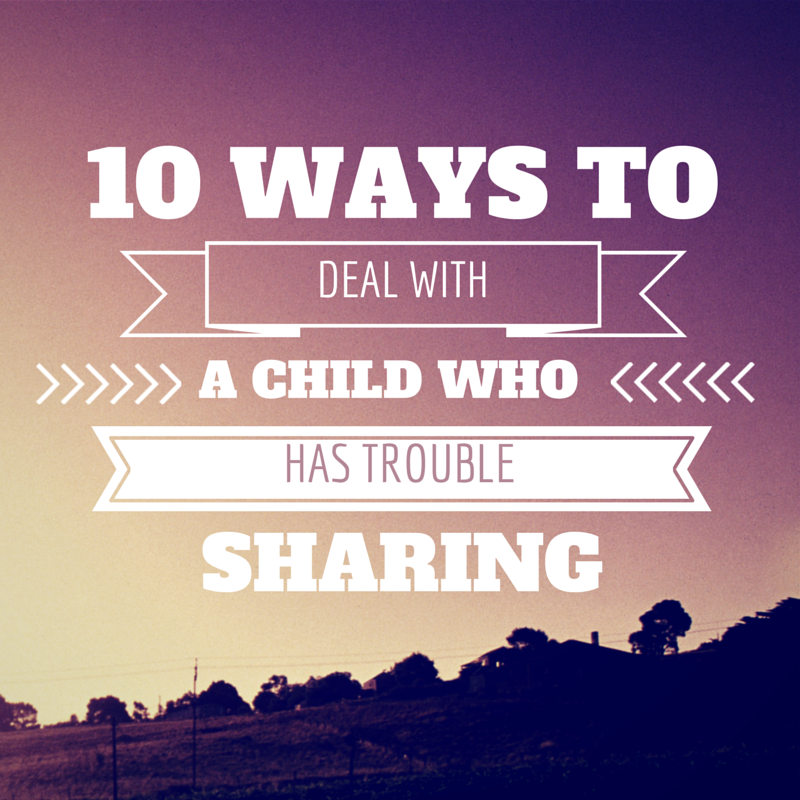10 ways to deal with a child who has trouble sharing Montessori-style

Why is it difficult to share?
When a baby is around a year, another child can usually walk up to them, take the toy they are playing with out of their hands and the baby will turn around and pick up the next closest toy.
Then, around 16 months, they begin to have difficulty with someone taking something off them that they are playing with. They may be playing with the cow and pig in the farm when another child takes another animal, for example, the horse. To the toddler this is also part of their activity and they can become very upset.
Toddlers find it particularly difficult to share an activity with another child as they are generally working on the activity to master it. For example, if it is a 9-piece puzzle, they want to complete and master the whole puzzle. If another child interferes and takes a piece, they are then unable to finish their work.
Parents find it difficult to understand why their child won’t let the other child play too. It is hard for us to see our child snatch something off another child or to see them get angry, sad or frustrated.
In reality, the toddler is following their impulse. And this is generally stronger than the rules they may have learned.
Around 2.5 to 3 years, the child may want to start to play together with another child. However, they often still need help to address any problems, for example, when they want to ask to play together, when they decide they would like to play by themselves etc.
1. Sharing by taking turns
Instead of being forced to play together and share, I suggest sharing by taking turns. The child who is playing with the activity can play with the activity as long as they like – this enables the child to increase their concentration, they can repeat it more than once to work on mastery of the activity and they can complete the activity by themselves.
They can tell the next child, “It will be available soon.” When the activity is finished and returned to the shelf, the next child can have their turn. Or they can offer the finished activity to the other child. They are still sharing the activity, just one after the other rather than simultaneously.
And the other child learns a valuable lesson to wait their turn.
2. If your child snatches a toy off another child
First I empathise with the child, “It really looks like you want to play with the vehicles.”
Then I explain that we take turns, “Jenny is having a turn at the moment. They’ll be available soon.”
If they are having trouble waiting, I can help them to wait. For example, I might offer a choice, “would you like to watch or would you like to find something else to play with in the meantime?”
If they are sad, I wait until they have calmed down offering them as much help as they need to calm down.
Once calm, I get them to make amends with the other child, for example, returning the vehicle or if the other child is upset to get a tissue for them.
3. Teach your child to be assertive
If your child is playing with a toy and another child takes it off them, I like to teach them to stand up for themselves. “You can tell Nicole that it’s your turn and it will be available soon.”
4. What if my child hits/bites/becomes aggressive?
A child may become aggressive if a toy is taken off them or if they are having difficulty waiting.
Again I would start with empathy – “You really wish you could play with the toy right now!”
Stop the aggressive behaviour – “I can’t let you hit him because their safety is important. You can show me how angry you are with this pillow” or “You can show me how angry you are – here is a paper and pencil. Show me how angry you are with a picture!”
Once they have calmed down, I would remind them to use their words. “You can ask him if you can have a turn next.”
It is also a good idea to stay close by if your child is having a difficult period taking their turn so you can guide them to wait their turn.
5. In the playground and public places
Sharing by taking turns works well in our Montessori playgroup where everyone knows how we deal with this difficult situation. But what about when you are in the playground or other public place or with friends that think they should share?
I find it ok to say to the other child, “It looks like you’d like a turn. You can have a turn when Mollie is all done.” Then they (and their parent) knows that you are not just being rude but allowing your child to finish.
Rather than staying with the activity until my child is completely done, I might cut their turn a little short to meet social obligations. For example, if there is another child waiting to use the swing, I would say something like, “I see another child waiting to use the swing. Let’s count to 10 and then we’ll give them a turn.”
6. Role playing at home
If your child is having difficulty taking turns, it is also an idea to role play different situations at home. Then, as you head out to play with friends or to the park, you can run through a few of the things you have practised. “What do we say if someone wants to play with our toy?” etc.
7. Playdates at your house
When you invite another child or children to your house, your child may have difficulty letting them play with their things.
It can be a good idea to prepare the space before your guests arrive. Even with young children, I ask them beforehand if there are any toys that are special to them that they would prefer to pack away before their friends arrive. Then I would check with them if they are happy for their friends to play with the other toys when they visit. It can still be difficult, but definitely helps prepare themselves and gives them some control over what their friends can play with.
8. Practising with working together
As the child becomes a little older, around 3 years, they are practising playing together with other children. For example, they may want to work with the play dough at the same time as another child. They practise asking the other child if they can join in. Sometimes they find it difficult to share. So we are helping them with their words and managing the situations that come up. “It looks like Peter wants to play by himself now. Let’s come back later and you can have a turn then.”
9. Stay calm and guide them
It is also best if you can stay calm yourself so that you can guide them and give them just as much help as needed to solve any problems. Sometimes the children are able to resolve it without you having to step in; sometimes your child may need some reminders; and other times when things get physical, we may need to step in to stop someone being hurt. This support can be done with love, but with clear boundaries.
10. Let siblings work out most of the low level disputes themselves
In our house, we had a rule that we share by taking turns. And beyond this, I tried to let the children resolve the problems themselves. For example, “One truck and two kids – that is a problem. Let me know how you work it out.”
If the conflict escalates, you may need to step in to help mediate between your children. However, I always say “Be Switzerland” – avoid taking sides and provide support for both parties.
Another perspective
For a slightly different perspective, I would like to share this Janet Lansbury article: http://www.janetlansbury.com/2014/06/share-wait-your-turn-dont-touch-playdate-rules-that-limit-learning-and-what-to-try-instead/.
The writer advocates that it’s best for an adult not to step in so that the children can creatively move through the conflict. I’m not sure I agree with this approach if an older or stronger child continues to take toys from another child.
But I do think this approach could work with siblings or with children that spend a lot of time together and are able to work together to solve the problem. Worth having a read.

Simone Davies has more than 20 years’ experience as an AMI Montessori educator. Simone is the author of “The Montessori Toddler” and co-author of “The Montessori Baby” and “The Montessori Child” books, comprehensive guides to raising children in a Montessori way. She currently runs parent-child Montessori classes in Amsterdam at her school Jacaranda Tree Montessori. She also has a popular blog, instagram and podcast “The Montessori Notebook” and is mother to two young adults.